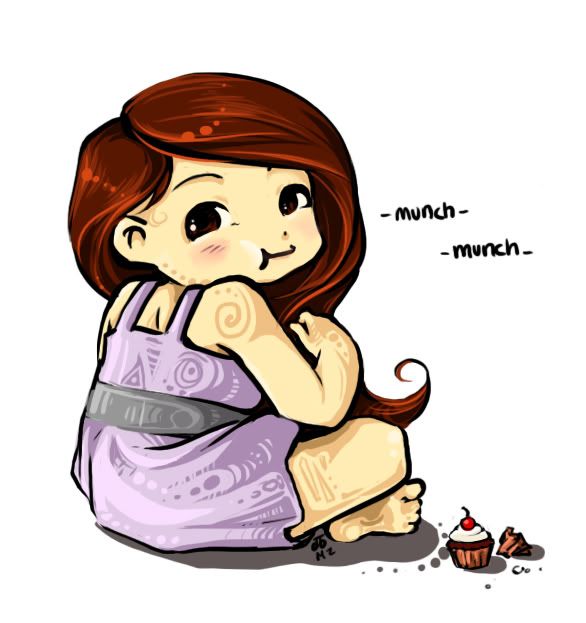Until my new website is complete, I will be taking a little cupcake break to focus on work, art, and life.
See you all later!
September 26, 2010
Taking a Snack Break
Part of my life:
art
April 25, 2010
4th Annual NYCAASC: Food in Motion Panel and More
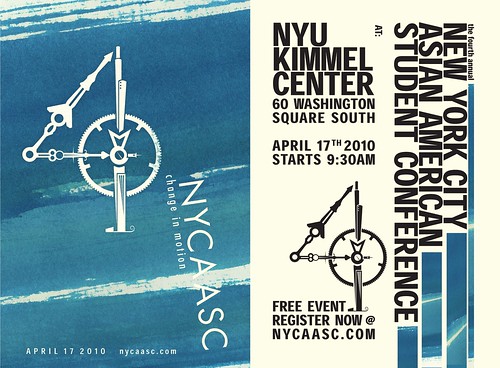
Saturday, April 17th, marked the culmination of months of extensive planning for the 4th Annual New York Asian American Student Conference (NYCAASC). In a nutshell, it is a full-day completely free, NYC student-organized event dedicated to raising awareness of Asian/Pacific/American (APA) issues, primarily to students, but it's open to anyone in the general public who is interested. The day revolves around three "tracks" of workshops, with some truly inspiring speakers, and includes FREE breakfast, lunch, snacks, dinner, and concerts at night. There are some icebreakers and a newly revamped Quizbowl to get the conversation rolling among the attendees too. So, basically it's free food, entertainment, and lots of learning. What's to lose with something that has no strings attached?
My role in NYCAASC was a workshop coordinator, which means I selected topics, reached out to potential speakers, and tried to keep my G-mail inbox from imploding. It was my pleasure to help facilitate a really informative panel about Entrepreneurship: Making our OWN Opportunities, co-sponsored by the Asian-American Entrepreneurs Network (http://www.aen-nyc.com), and moderated by Ramon Gil. The panel that I primarily worked on, since I had more personal knowledge and experience, was about Food in Motion:Asian Americans Changing the Culinary Scene.
How do Asian Americans affect America's ever-fluctuating culinary scene? We are no longer constrained to close-quartered, run-down, stone-walled Chinatown spaces, but instead are branching out into new areas, new methods of distribution, and new integrations of food and culture. Even the idea of a traditional recipe has been taken with a grain of salt, challenged, and pushed to shape what the American public understands as “Asian food." As our modes of innovation and representation change, so does the American palate, and thus, Asian cuisine in America as we know it.
Speakers: Joseph Tien (Mantao Chinese Sandwiches), Thomas Yang (NYC Cravings truck), Emery Huang (Baohaus), Jerome Chang (Dessert Truck Works), Christina Seid (Chinatown Ice Cream Factory)
Moderated by: Melissa Zhang
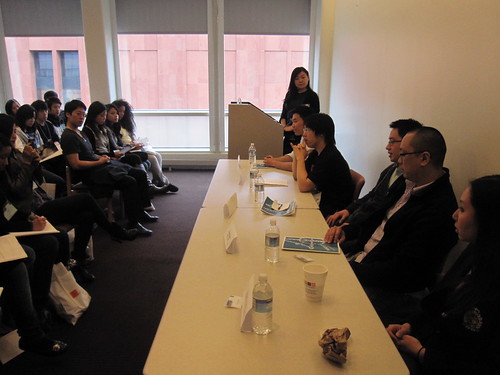
The panel was dynamic and covered a breadth of topics, from price point and premiums to modes of distribution and space, community support or backlash, authenticity versus innovation, and media representation of Asian food. You can actually find a great video clip of the panel, captured by the folks at Baohaus here:
NYU Food Panel from Hoodman Clothing on Vimeo.
All the speakers gave really insightful responses, and I wish we had more than 70 minutes for the workshop. The crowd had filled up all the chairs and were even sitting on the ground! For this being my first time moderating, I was happily surprised by the turnout of people who were interested in learning more about Asian Americans in the food industry.
There was some minor gripe about this being a Chinese American-heavy panel, or there not being samples of food (what free dinner afterwards?), but the final line is that you can't cover all the bases. We do what we can to get the ball rolling, and hope that the result will ignite future discussions and changes. This is, after all, Change in Motion, especially for Food in Motion. I encourage everyone to go out and visit these business owners' places, and put our money where our mouths are to support the community and honestly, just flat out good food.
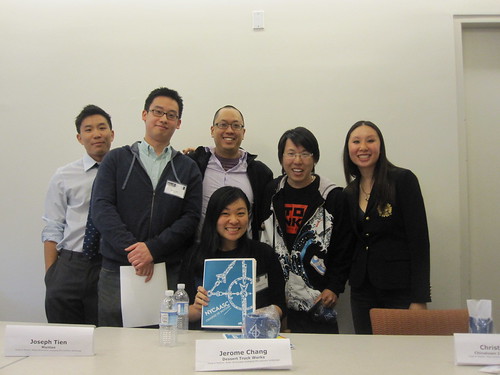
I want to extend a big "THANK YOU" to everyone who saw me through this process. The end conclusion was worth all the missed brunches due to 5-hour meetings every Sunday for the past half year of planning. So here's where I get all mushy and sentimental, but I do mean every word.
To the speakers, if we haven't said it enough, I want to pen it in digital ink how much we appreciate you setting aside the time to speak at the conference. I hope that this experience and the follow-up comments will help motivate you to keep up the great work that you're doing.
To the NYCAASC board, this was one of the most rewarding and impactful things I've ever done. I am so impressed by everyone in the planning committee for their dedication and hard work, and I'm already looking forward to joining other alumni in next year's 5th NYCAASC.
To friends and new faces alike who showed your support, whether by helping spread the word or coming to attend, it means a lot to me. You guys kept me from turning into a ball of nerves, and the kind words and follow up comments have really made me smile. Let's go eat a celebration dinner!
Most of all, it was FUN. Tiring, but fun. We talked about whales, nuts, and of course, ideas that the creative energy from all of the ideas flowing around sparked. I'm grateful for the opportunity to make my various interest intersect, and to bring some people along for what was hopefully, a fun ride.
April 20, 2010
Thanks for the health boost, San Francisco!
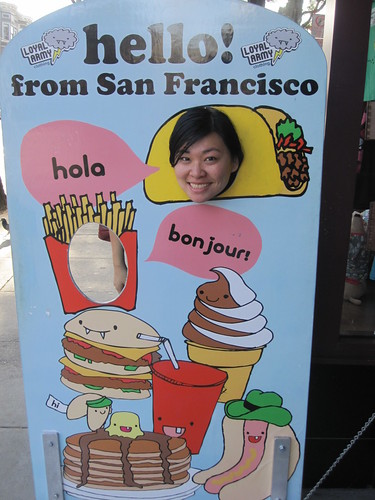
After a whirlwind self-guided gastronomic tour around San Francisco, I have to say, I don't think there's a better way to experience a city than by eating through it. A conversation I had on my last day there went something like this:
"Is there anywhere else I should go on my last day?"
"Where have you already been?"
"Well, I've hit up most of the places I wanted to eat at."
"What else have you seen or done besides eat?"
"I thought eating was sightseeing."
....isn't it?
I did come away from my trip with certain thoughts. There's a long-standing debate about which U.S. coast's approach to food reigns supreme. San Francisco is proud of its local, organic, sustainable, fresh, farmer-approved produce as much as New York is happy to offer exuberant fine dining and encourage molecular gastronomy. But it's not so much apples to oranges as it is that even though both coasts see the benefits of each argument, there is just a preference and emphasis on one over the other. I don't think Californians really would "serve a [carrot] on a plate with nothing on it" (-D.C) , just as one would hope that New York is not serving up deconstructed week-old carrots.
There's also an interesting use of food as a way to support the community. Apparently there is an increasing pressure on restaurant owners to provide adequate health care and worker benefits to their staff in the face of rising costs. This extra cost is reflected onto the customer in an popular solution of adding a surcharge onto diners' checks.
I first noticed this "SF Health Care Ordinance" as an extra $1/person to all checks during brunch at Zazie, then the "Healthy San Francisco Initiative" in the form of a 4% surcharge onto the final bill at Boulevard. This is touchy territory to discuss, especially from an non-local perspective, but my inclination is to agree with the opinions expressed on SF Gate: Enough with the surcharges, just add in the costs to the menu prices. A justification for rising menu prices would make it easier to swallow than a salient, clear, printed reminder of an inescapable surcharge before you even order. Plus, if it's optional or at least less rigidly defined, there is the choice of giving more or less as desired.
Then there are these new compost receptacles next to each apartment's garbage and recyclable cans. According to the Sacramento Bee, even though composting and environmentally friendly practices have existed for awhile, there is an increasing alert and attention to this issue now there is a threat that residents can be fined for not sorting out their biodegradable and food composts into the right bins. I can't help but wonder, who and where are the Compost Police?
I first noticed this "SF Health Care Ordinance" as an extra $1/person to all checks during brunch at Zazie, then the "Healthy San Francisco Initiative" in the form of a 4% surcharge onto the final bill at Boulevard. This is touchy territory to discuss, especially from an non-local perspective, but my inclination is to agree with the opinions expressed on SF Gate: Enough with the surcharges, just add in the costs to the menu prices. A justification for rising menu prices would make it easier to swallow than a salient, clear, printed reminder of an inescapable surcharge before you even order. Plus, if it's optional or at least less rigidly defined, there is the choice of giving more or less as desired.
Then there are these new compost receptacles next to each apartment's garbage and recyclable cans. According to the Sacramento Bee, even though composting and environmentally friendly practices have existed for awhile, there is an increasing alert and attention to this issue now there is a threat that residents can be fined for not sorting out their biodegradable and food composts into the right bins. I can't help but wonder, who and where are the Compost Police?
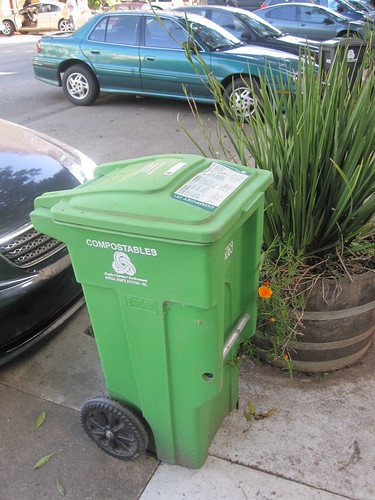
So although that's great for San Francisco and all the residents who support and are willing to go along with these acts, the question that interest me is whether or not New York or other major cities would be so eager to adopt such policies. I think that when comparing the population size of Manhattan's 2+ million versus San Francisco's roughly 700K, excluding other boroughs, there are simply too many people and not enough space and time to enforce these rules without backlash from a vast yet divided community that is less likely to share similar values.
But that's just my take on it. What do you think? Could a common surcharge ever fly in New York? Would you also compost if you already had recycle and trash bins? Speak your mind in the comments section.
Oh, but I wouldn't argue against getting some of these:
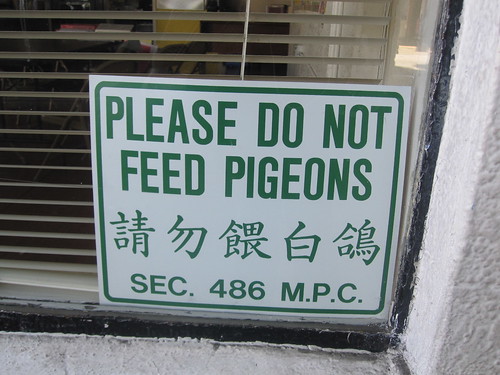
Looking back on all my travels, my most memorable experiences have always involved food. Either this or that landmark or event was sandwiched by a great meal, or permanently bookmarked by a particular food's taste. The freshly caught and fried fish I had in Elephant Trunk Mountain in China, the wine tasting event on the steps of the Palazzo Pitti in Florence, or the Flushing dumpling tour to bid farewell to 2009, are ingrained in my mind by food. And so, I'll remember San Francisco, with all its beautiful scenery and the wonderful people that I met, by the food I shared when I was there.
All in all, this pretty much sums up what I thought of San Francisco:
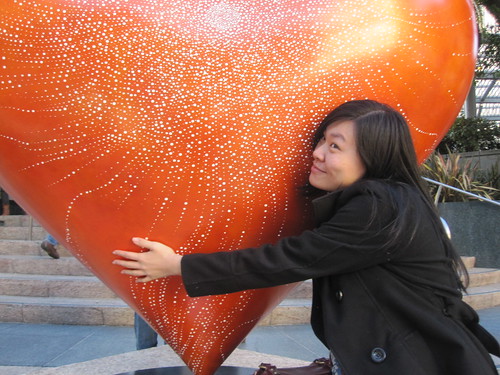
Now back to our regularly scheduled New York food news.
Part of my life:
environment,
health,
restaurant rules,
San Francisco,
travel
April 8, 2010
The Sweet Side of San Francisco
Sugar junkie that I am, most of my trip was spent finding as many sweets as I could in San Francisco. Some people visit the city to indulge their inner tech geek, some for the non-smog-filled air and scenic views, and others simply want to reap the benefits of fresh, organic vegetables with some locally caught fish. Good for them, but my trip - sans one Mission-style burrito - was solely sugar-focused. Left to wander on my own, I was a sugar fiend on a mission.
Now without further ado, here's a breakdown of my findings, including an unexpected favorite at the end.
Ideal Heat Stroke Prevention
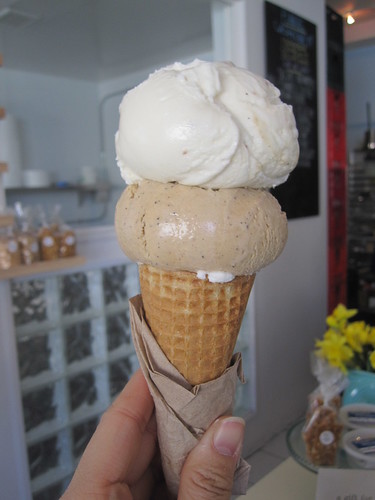
Now this is what I'm talking about. San Francisco is a nature-lover's city, blooming with flowers and greens everywhere you look - that is, if you can see past the peak of the hills. Quality ice cream on a sunny day in the park was exactly what the Sugar Doctor recommended.
After walking two miles in 90 degree weather in a show of stubborness against public transportation, the thought of ice cream with Stephanie of Lick my Spoon was an oasis beckoning to me. From the no-frills, down to earth grocery store Bi-Rite Creamery, to the more refined Humphry Slocombe, you can't go too wrong with any of the flavors offered there.
Sugary Tracks: Bi-Rite Creamery (Dizzying rainbow of flavors,with a line around the corner to match), Humphrey Slocombe (I'd like to wake up everyday to a bowl of "Secret Breakfast" (pictured) of Cornflakes and Bourbon. Word to the wise, skip the DuckFat Pecan Pie. It sounds better than it tasted.), Ciao Bella Gelato (Ferry Building)
Mission Impossible: Cupcakes
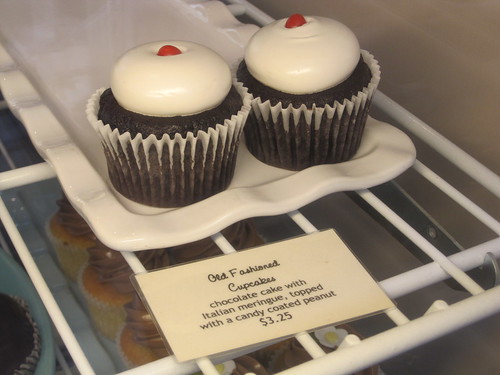
In a city with about a third of the population of Manhattan, I shouldn't have been surprised to find that the saturation of cupcakeries reflected this. Fine, point taken. But I was also approaching it with New York expectations of eccentricity and food experimentation. I hunted near and far in San Francisco for signature cupcakes, but every cupcake I had was just "okay". Maybe I'd seen one Sea Salted Chocolate Cupcake too many in my life, but I soon gave up my passionate pursuit of this particular quest, partly because I was so distracted by other stronger desserts.
Sugary Tracks: Miette (didn't try their famous Gingerbread, but the Old-Fashioned (pictured), was an impressive sink-and-melt-in-your-mouth chocolately morsel), Love at First Bite (Berkeley), Kara's Cupcakes, Arlequin (Ferry Building Farmer's Market; more adventurous flavors)
The Cutest Type of Cookie
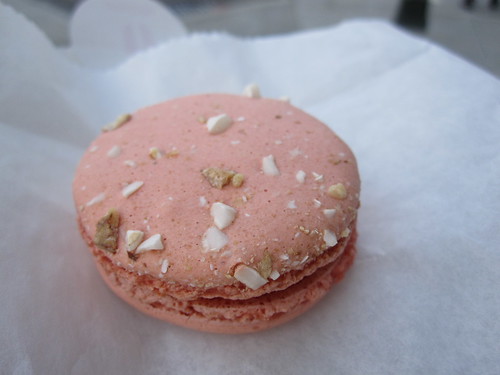
French macarons are some of my favorite pocket-sized treats. Small enough for a satisfying sugar kick in the middle of the day, but deliciate enough to be too frustrating for this home baker. Imagine my delight when I realized that where San Francisco fell short in the cupcake division, French macarons were scattered throughout the city like colorful buttons of sugary pick-me-ups. The price and quality of these tiny "cookies", and I use the term loosely, more than made up for any other shortcomings.
Sugary Tracks: Paulette Macarons (Sweet Wedding Almond (pictured) is as adorable as its name), Miette (Pistachio macarons are NOT green, but naturally colored and filled with cloudlike Swiss buttercream), Schoggi (Swiss chocolates, but pretty decent macarons too)
Culture Crash Course in Chinatown

As soon as I heard about it, I knew I couldn't leave without visiting Golden Gate Fortune Cookie Factory. And apparently neither could two tour groups before me, nor the three coming up the hidden alleyway after me. I don't blame them, there's a certain allure to the secrecy of this place, and the smiling Chinese senior waiting to welcome you with a plate of fresh-off-the-press samples.
Surprisingly, the flat disc versions that haven't been pressed into the familiar folded nests for fortunes bring more focus onto the food item itself. There's an addictive power to these snacks that stems from their satisfying crunch and a strong vanilla flavor. My mind was boggled by a bag of chocolate-vanilla-strawberry fortune cookies.
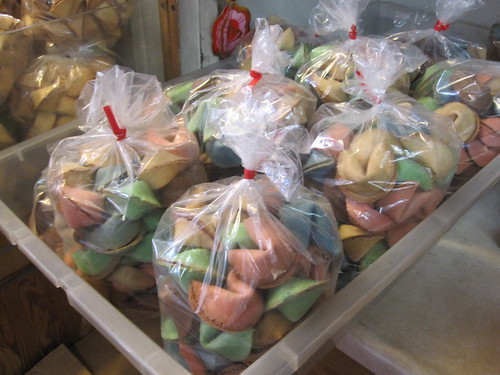
Who knew you could do so much with these simple snacks? Most of us only eat these things at the end of every Chinese restaurant meal because we're eager to see words of wisdom or confusion are inside. Not here though; be prepared to fess up some change to include your own fortune, and even to take a photo inside the factory.
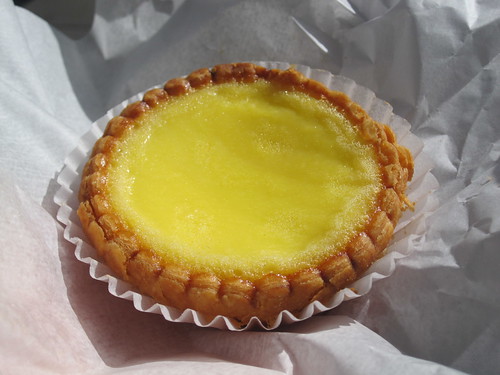
If you think you know egg custard tarts, you haven't tried the ones at Golden Gate Bakery. With that kind of unimaginative name, you don't go in expecting much, or even know what to get. There's no question about it: get the egg custard tarts. Ignore the grouchy ladies and the nonexistent decorations, and try to spot the fresh baked goods. When I went, I spied a tray of them balanced precariously on top of a tower of Chinese newspapers.
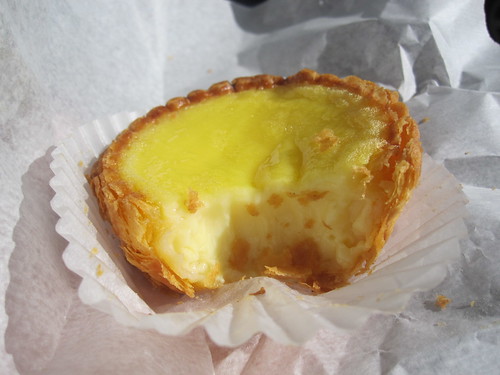
These tarts are definitely for those who prefer more custard filling. There's a visibly skewed balance of mostly soft, warm, eggy custard barely cupped by flaky puff pastry crust instead of the more common butter crust. A word of advice is to eat them on the spot, instead of saving a few for later like I did. Since they're more fragile, they don't keep well; the taste turns sickly sweet and the crust soggy and misshapen after a few hours.Which means, you might have the oh-so-horrific task of going back to get more the next morning.
The Expensive, the Famous, the Over-hyped
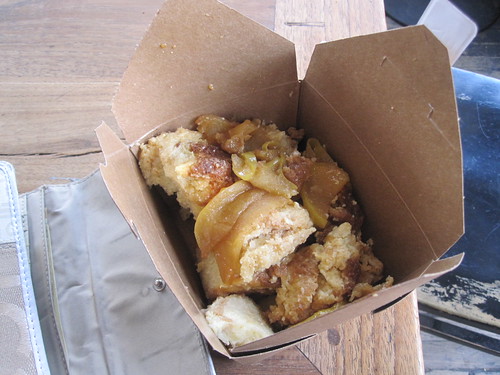
I had pretty high hopes for this James Beard Foundation recognized bakery. But Tartine's "famous" bread pudding, warmed up or chilled through, and carefully analyzed, was unremarkable at best and a letdown in reality.
Maybe I should've tried a buttery croissant or their abundant array of Valrhona chocolate desserts, but the staff's unenthusiastic responses didn't exactly convince me to shell out more money when there are so many other tempting places nearby. Bi-Rite is literally around the corner. Perhaps I just came on an off day, but I left unimpressed.
Hot Enough to Play for the Other Team

Hot cookie, if you were a man, you'd have the hearts of every man and woman walking down the Castro. You've even won over this cookie skeptic. And I'm not even talking about your NSFW shaped cookies either, though those are definitely amusing. I'm talking about the lethally delicious Snickerdoodle.
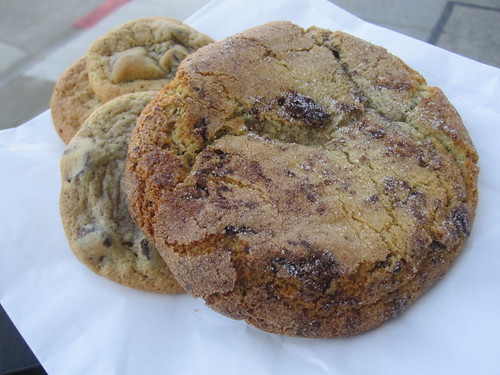
Snickerdoodles are not my cookie of choice, but I heard great things about the ones here. So I bought one. And I took a bite. And then another. And suddenly, even after a filling lunch and extensive cupcake tasting with cupcake blogger Chockylit, somehow only crumbs remained at the the bottom of my paper bag. I was as shocked by how quickly I'd devoured it as I was by how delicious and worth the extra calories. The toffee and mini chocolate chip ones did not disappoint either, but my heart had already been stolen by the Snickerdoodle.
Without resorting to the regular tactics of overusing butter or underbaking, the cookies here are large discs of pure edible euphoria. Hot Cookie was my unexpected, overarching favorite out of my trip to San Francisco, enough so that this was the only place I returned to grab a momento from before I left for my return flight to NYC.
Of course, there is so much more that I haven't covered. I do have to leave some territories left unconquered for my next trip, after all. But for a casual day trip of sweets, you can't go wrong with the Ferry building or the Mission, and also the Castro. If anyone wants a specific dessert walking path, I can guide you along what I did for maximum tasting without going overboard. So, with this list and Blue Bottle coffee in hand, go tackle these sweets!
Each link either goes to a photo I took of the dessert, or the company website.Please click on them to see what dessert I'm referring to. Full set of photos can be found by clicking here. Please leave feedback, questions, and concerns about my health in the comments below!
Now without further ado, here's a breakdown of my findings, including an unexpected favorite at the end.
Ideal Heat Stroke Prevention

Now this is what I'm talking about. San Francisco is a nature-lover's city, blooming with flowers and greens everywhere you look - that is, if you can see past the peak of the hills. Quality ice cream on a sunny day in the park was exactly what the Sugar Doctor recommended.
After walking two miles in 90 degree weather in a show of stubborness against public transportation, the thought of ice cream with Stephanie of Lick my Spoon was an oasis beckoning to me. From the no-frills, down to earth grocery store Bi-Rite Creamery, to the more refined Humphry Slocombe, you can't go too wrong with any of the flavors offered there.
Sugary Tracks: Bi-Rite Creamery (Dizzying rainbow of flavors,with a line around the corner to match), Humphrey Slocombe (I'd like to wake up everyday to a bowl of "Secret Breakfast" (pictured) of Cornflakes and Bourbon. Word to the wise, skip the DuckFat Pecan Pie. It sounds better than it tasted.), Ciao Bella Gelato (Ferry Building)
Mission Impossible: Cupcakes

In a city with about a third of the population of Manhattan, I shouldn't have been surprised to find that the saturation of cupcakeries reflected this. Fine, point taken. But I was also approaching it with New York expectations of eccentricity and food experimentation. I hunted near and far in San Francisco for signature cupcakes, but every cupcake I had was just "okay". Maybe I'd seen one Sea Salted Chocolate Cupcake too many in my life, but I soon gave up my passionate pursuit of this particular quest, partly because I was so distracted by other stronger desserts.
Sugary Tracks: Miette (didn't try their famous Gingerbread, but the Old-Fashioned (pictured), was an impressive sink-and-melt-in-your-mouth chocolately morsel), Love at First Bite (Berkeley), Kara's Cupcakes, Arlequin (Ferry Building Farmer's Market; more adventurous flavors)
The Cutest Type of Cookie

French macarons are some of my favorite pocket-sized treats. Small enough for a satisfying sugar kick in the middle of the day, but deliciate enough to be too frustrating for this home baker. Imagine my delight when I realized that where San Francisco fell short in the cupcake division, French macarons were scattered throughout the city like colorful buttons of sugary pick-me-ups. The price and quality of these tiny "cookies", and I use the term loosely, more than made up for any other shortcomings.
Sugary Tracks: Paulette Macarons (Sweet Wedding Almond (pictured) is as adorable as its name), Miette (Pistachio macarons are NOT green, but naturally colored and filled with cloudlike Swiss buttercream), Schoggi (Swiss chocolates, but pretty decent macarons too)
Culture Crash Course in Chinatown

As soon as I heard about it, I knew I couldn't leave without visiting Golden Gate Fortune Cookie Factory. And apparently neither could two tour groups before me, nor the three coming up the hidden alleyway after me. I don't blame them, there's a certain allure to the secrecy of this place, and the smiling Chinese senior waiting to welcome you with a plate of fresh-off-the-press samples.
Surprisingly, the flat disc versions that haven't been pressed into the familiar folded nests for fortunes bring more focus onto the food item itself. There's an addictive power to these snacks that stems from their satisfying crunch and a strong vanilla flavor. My mind was boggled by a bag of chocolate-vanilla-strawberry fortune cookies.

Who knew you could do so much with these simple snacks? Most of us only eat these things at the end of every Chinese restaurant meal because we're eager to see words of wisdom or confusion are inside. Not here though; be prepared to fess up some change to include your own fortune, and even to take a photo inside the factory.

If you think you know egg custard tarts, you haven't tried the ones at Golden Gate Bakery. With that kind of unimaginative name, you don't go in expecting much, or even know what to get. There's no question about it: get the egg custard tarts. Ignore the grouchy ladies and the nonexistent decorations, and try to spot the fresh baked goods. When I went, I spied a tray of them balanced precariously on top of a tower of Chinese newspapers.

These tarts are definitely for those who prefer more custard filling. There's a visibly skewed balance of mostly soft, warm, eggy custard barely cupped by flaky puff pastry crust instead of the more common butter crust. A word of advice is to eat them on the spot, instead of saving a few for later like I did. Since they're more fragile, they don't keep well; the taste turns sickly sweet and the crust soggy and misshapen after a few hours.Which means, you might have the oh-so-horrific task of going back to get more the next morning.
The Expensive, the Famous, the Over-hyped

I had pretty high hopes for this James Beard Foundation recognized bakery. But Tartine's "famous" bread pudding, warmed up or chilled through, and carefully analyzed, was unremarkable at best and a letdown in reality.
Maybe I should've tried a buttery croissant or their abundant array of Valrhona chocolate desserts, but the staff's unenthusiastic responses didn't exactly convince me to shell out more money when there are so many other tempting places nearby. Bi-Rite is literally around the corner. Perhaps I just came on an off day, but I left unimpressed.
Hot Enough to Play for the Other Team

Hot cookie, if you were a man, you'd have the hearts of every man and woman walking down the Castro. You've even won over this cookie skeptic. And I'm not even talking about your NSFW shaped cookies either, though those are definitely amusing. I'm talking about the lethally delicious Snickerdoodle.

Snickerdoodles are not my cookie of choice, but I heard great things about the ones here. So I bought one. And I took a bite. And then another. And suddenly, even after a filling lunch and extensive cupcake tasting with cupcake blogger Chockylit, somehow only crumbs remained at the the bottom of my paper bag. I was as shocked by how quickly I'd devoured it as I was by how delicious and worth the extra calories. The toffee and mini chocolate chip ones did not disappoint either, but my heart had already been stolen by the Snickerdoodle.
Without resorting to the regular tactics of overusing butter or underbaking, the cookies here are large discs of pure edible euphoria. Hot Cookie was my unexpected, overarching favorite out of my trip to San Francisco, enough so that this was the only place I returned to grab a momento from before I left for my return flight to NYC.
Of course, there is so much more that I haven't covered. I do have to leave some territories left unconquered for my next trip, after all. But for a casual day trip of sweets, you can't go wrong with the Ferry building or the Mission, and also the Castro. If anyone wants a specific dessert walking path, I can guide you along what I did for maximum tasting without going overboard. So, with this list and Blue Bottle coffee in hand, go tackle these sweets!
Each link either goes to a photo I took of the dessert, or the company website.Please click on them to see what dessert I'm referring to. Full set of photos can be found by clicking here. Please leave feedback, questions, and concerns about my health in the comments below!
Part of my life:
bakery,
chinatown,
cookies,
cupcakes,
dessert,
egg tart,
fortune cookie,
ice cream,
San Francisco,
sugar,
sweets,
travel,
walking guide
April 1, 2010
The Essential SF Meal: Burritos in The Mission
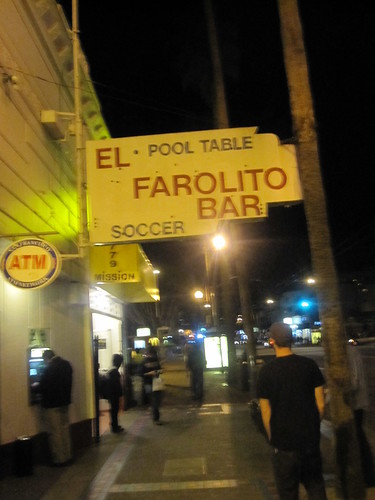
When I asked for recommendations before, and during, my trip to San Francisco, one answer kept popping up: get a burrito in The Mission district. And apparently not just any burrito, but one from El Farolito.
Now with that in mind, it seemed a crime against destiny not to go and try that signature food item of San Francisco. California has some well known names, such as In-N-Out, but burritos are to San Francisco what bagels are to New York. There's a certain art to what makes for a "perfect" final product. So then, onto El Farolito.
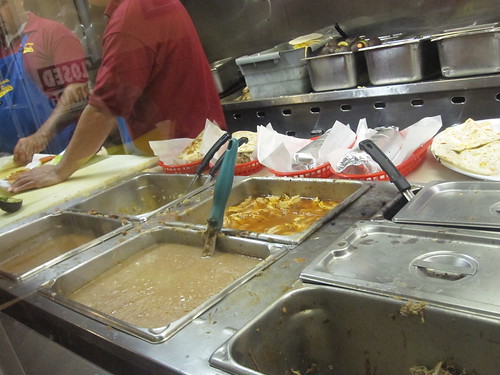
First off, the Mission is not the most glamorous of neighborhoods, so the barebones, pretention-out-the-window setup of El Farolito made sense. My friend and I joined the line of construction workers, hipsters, and even suits, to place an order with the man behind the counter who cared only if you wanted your burrito super or regular.
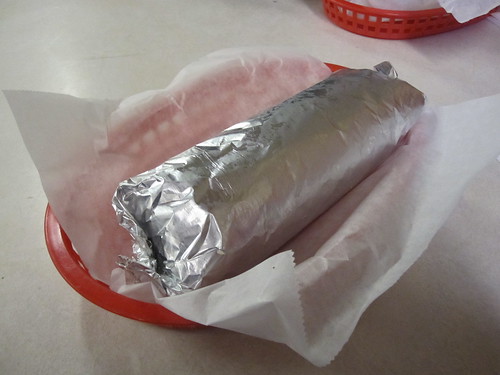
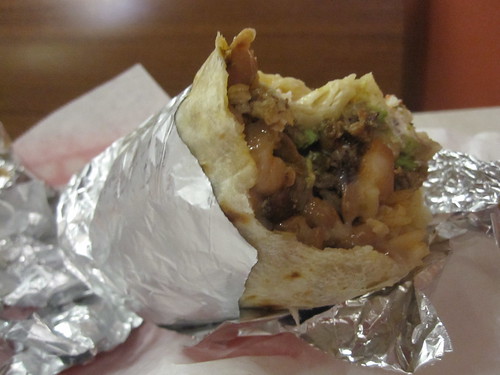
My friend ordered the Super Al Pastor Burrito with marinated pork, rice, cheese, salsa, beans, sour cream, and avocados. An upside down shot of his burrito reveals the balanced layers of each ingredient, wrapped in a manner that he happily called "the right way to fold a burrito." Cyclists, who have a much bigger presence in San Francisco, should be able to grab these cheap, filling, and fast meals and eat them on the go without the shell tearing. The tortilla was indeed my favorite part, thick enough to hold the filling, but thin enough with a flaky skin to add a little texture.
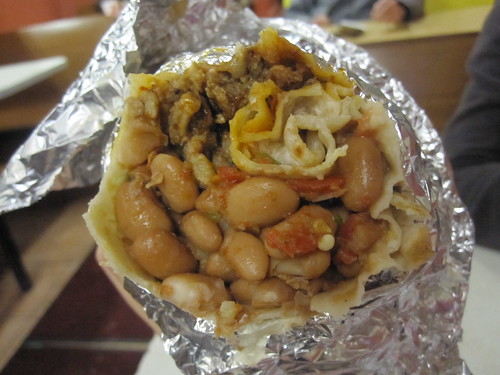
After a day of continuous food stops throughout the day, I only had room to try the Regular Al Pastor Burrito, which was pretty much just pork, rice, salsa, and beans. I was never the biggest fan of rice, so I asked to have it left out, not realizing what that would mean for my final order. As such, my version ended up being composed of about 80% beans.
I had to dig to find the pork and the salsa, or had to scrape out some of the beans to equal it out. Looking back on it, I should've gotten the Super Burrito. But at the same time, shouldn't good ingredients and a balance between simpler elements still make for a great burrito, regardless?
While it wasn't life-changing for me, it's definitely an item worth trying in San Francisco. There were other intriguing meats on the menu, such as Beef Head Meat or Beef Brains, for the adventurous eaters. At less than $6 for most burritos, it'll be enough to leave you with enough left over to try the sweets right around the corner.
El Farolito
2779 Mission St
(between 23rd St & 24th St)
San Francisco, CA 94110
(Multiple Locations)
Part of my life:
burrito,
famous,
mexican,
San Francisco,
travel
March 23, 2010
Wine Overdose: Napa Valley and Beyond
There's little debate that Napa Valley is a must-go destination for wine drinkers. It's a great place for beginners and connoisseurs alike to get a sense of what makes Napa county so special, and especially for locals who want to get a fuller understanding of where their wine comes from. The climate and geography are well suited for growing a variety of grapes, so there are an understandably high saturation of estates in the area. One of the hardest tasks then, is narrowing down which places to visit in an afternoon.
Knowing ahead of time how easy it can be to get overwhelmed with all the wineries around Napa, we decided to narrow down our list. We had four, but after taking into consideration tasting fees, travel time, and alcohol intake (on my end), we ended up focusing on two. We'd gotten a few recommendations for Domaine Chandon, so off we went to our first winery.
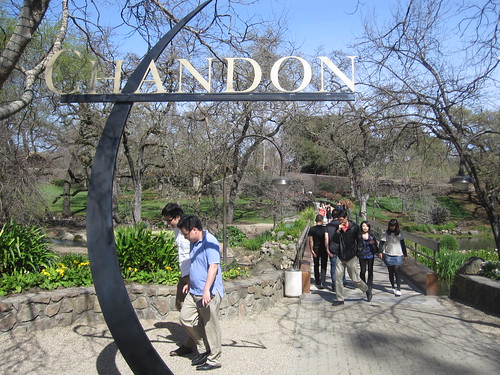
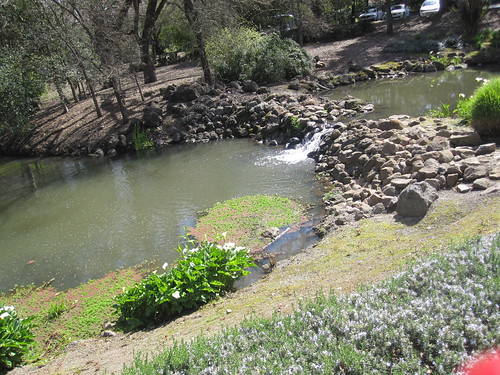
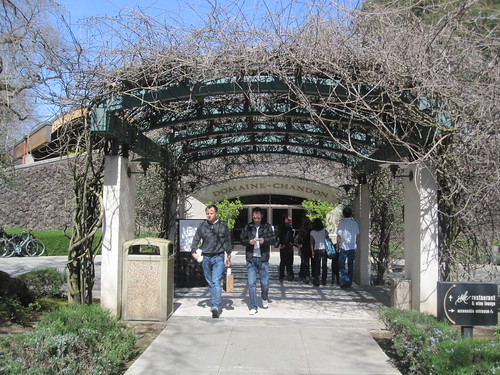
First of all, as evidenced above, the estate is hauntingly beautiful. I suspect a big part of why people come here is to enjoy the scenery. It's spacious, bright, open, and while the staff is less than ecstatic, the visual surroundings tend to take your mind off of other matters. But onto the wine.
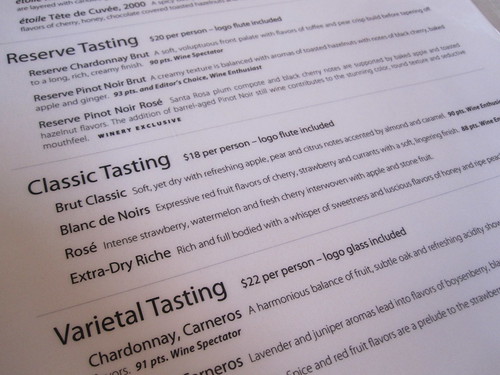
Domaine Chandon is best known for their sparkling wines, especially the Brut Classic, which my companions claimed was the most popular due to it being well stocked at corner stores. We opted for the Classic Tasting ($18), which included half pours of the Brut classic, Blanc de Noirs, Rose, and Extra-dry Riche, plus a souvenir Chandon flute glass.
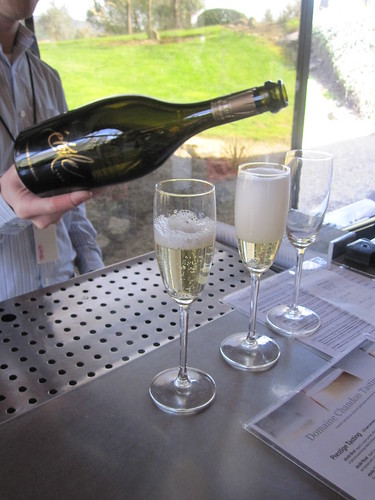
The inside restaurant Etoile seemed to be well rated, and I could easily imagine a leisurely afternoon lunch on their gorgeous patio with a (few) glass(es) of sparkling wine. At $18-25 for their tastings and a mark-up rather than a discount at the enclosed store, while I'm glad I went, I'm not sure I'd rush back here on future trips to Napa.
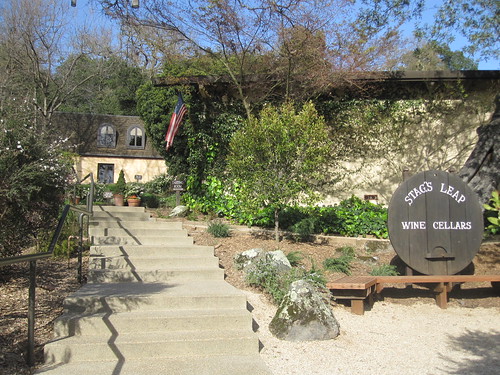
Next, we headed to a personal favorite of my San Franciscan host, who chanced upon it during a bike ride and has been a fan ever since. Stag's Leap Wine Cellars immediately had a much more rustic feel, as evidenced by the heavy wooden gate door, earthy tones, and even the name. The staff here also knew more about the estate's history, dating back to the 1976 Paris Tasting, when in a blind tasting, the American S.L.V. beat out French wineries for the first time, proving that the areas for good wine production had finally expanded.

A friend and I split the Napa Valley tasting ($15), which gave us two glasses each, one of the 2006 Merlot and one 2006 Cabernet Sauvignon Artemis. Stag's Leap produces more Cabernet Sauvignons, and I detected lingering hints of chocolate or cocoa powder.
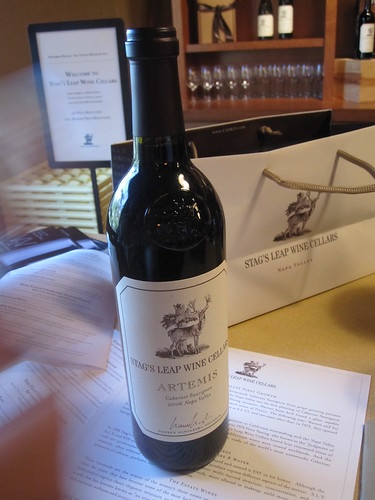
Knowing their history, I had to try their signature Cask 23. The tasting notes alone sounded amazing, of "warm berries and concentrated cassis, chocolate fudge, violets, and barrel spices", even if I didn't have the requisite $195 for the bottle. But we did go back with a bottle of the Stag Leap Artemis to pair with our dinner. Perhaps it was the "warm pie crust" tasting note that jumped out and caught my curiosity that time.
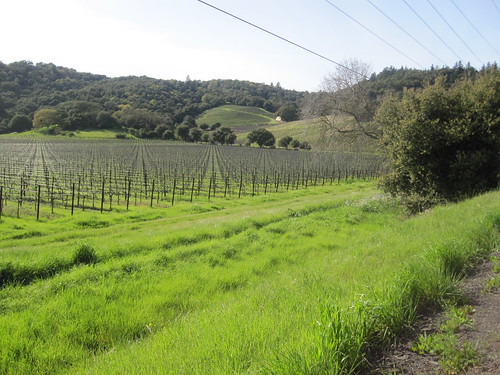
At this point, I was pretty much done, as I am a bit of a lightweight. Nevertheless, it was such a fun experience. I had a mission to finally visit Napa wine county after hearing so much about it, since I'm still new to wine and I believe in learning through first-hand experience. Not only that, but I hadn't anticipated just how pleasant and beautiful the scenery is in Napa Valley.
My friend Barce was the designated driver throughout the day, exhibiting a will of steel against our offers to taste the wines. In his typical good nature, and as a further sign of his hospitality, he even made us dinner that night. Home cooking is a treasured and rare experience for me, since I never cook at home for myself.
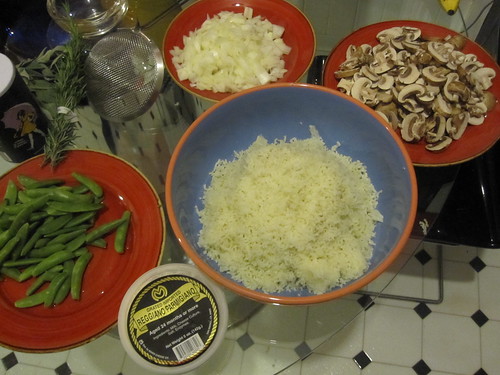
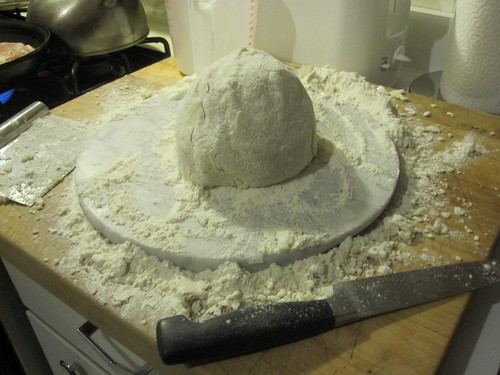
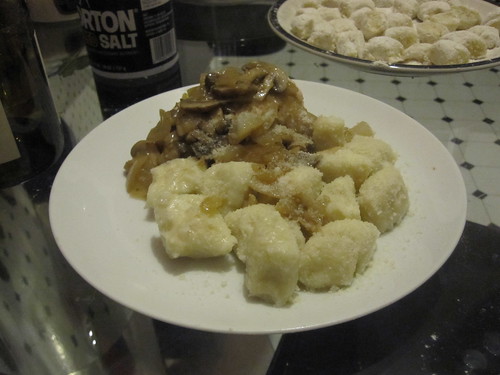
There was an immense satisfaction in popping open the bottle of red wine from his favorite Napa winery to go with our home-cooked meal. I had the fortune of dining on a juicy chicken breast with homemade gnocchi from scratch, dressed with a sauce of onions and mushrooms. For dessert, we continued our wine streak with Ciao Bella Blackberry Cabernet gelato, and I produced a box of Chateau de Margaux Armagnac soaked cherries.
Between our afternoon of wine tasting, the Chardonnay in our cooked meal, and the different alcoholic desserts, I think I've reached my wine quota of the month. Until my next visit, Napa Valley. I'll be nursing my liver in the meantime.
Domaine Chandon Winery
Stag's Leap Wine Cellars
www.CASK23.com
Knowing ahead of time how easy it can be to get overwhelmed with all the wineries around Napa, we decided to narrow down our list. We had four, but after taking into consideration tasting fees, travel time, and alcohol intake (on my end), we ended up focusing on two. We'd gotten a few recommendations for Domaine Chandon, so off we went to our first winery.



First of all, as evidenced above, the estate is hauntingly beautiful. I suspect a big part of why people come here is to enjoy the scenery. It's spacious, bright, open, and while the staff is less than ecstatic, the visual surroundings tend to take your mind off of other matters. But onto the wine.

Domaine Chandon is best known for their sparkling wines, especially the Brut Classic, which my companions claimed was the most popular due to it being well stocked at corner stores. We opted for the Classic Tasting ($18), which included half pours of the Brut classic, Blanc de Noirs, Rose, and Extra-dry Riche, plus a souvenir Chandon flute glass.

The inside restaurant Etoile seemed to be well rated, and I could easily imagine a leisurely afternoon lunch on their gorgeous patio with a (few) glass(es) of sparkling wine. At $18-25 for their tastings and a mark-up rather than a discount at the enclosed store, while I'm glad I went, I'm not sure I'd rush back here on future trips to Napa.

Next, we headed to a personal favorite of my San Franciscan host, who chanced upon it during a bike ride and has been a fan ever since. Stag's Leap Wine Cellars immediately had a much more rustic feel, as evidenced by the heavy wooden gate door, earthy tones, and even the name. The staff here also knew more about the estate's history, dating back to the 1976 Paris Tasting, when in a blind tasting, the American S.L.V. beat out French wineries for the first time, proving that the areas for good wine production had finally expanded.

A friend and I split the Napa Valley tasting ($15), which gave us two glasses each, one of the 2006 Merlot and one 2006 Cabernet Sauvignon Artemis. Stag's Leap produces more Cabernet Sauvignons, and I detected lingering hints of chocolate or cocoa powder.

Knowing their history, I had to try their signature Cask 23. The tasting notes alone sounded amazing, of "warm berries and concentrated cassis, chocolate fudge, violets, and barrel spices", even if I didn't have the requisite $195 for the bottle. But we did go back with a bottle of the Stag Leap Artemis to pair with our dinner. Perhaps it was the "warm pie crust" tasting note that jumped out and caught my curiosity that time.

At this point, I was pretty much done, as I am a bit of a lightweight. Nevertheless, it was such a fun experience. I had a mission to finally visit Napa wine county after hearing so much about it, since I'm still new to wine and I believe in learning through first-hand experience. Not only that, but I hadn't anticipated just how pleasant and beautiful the scenery is in Napa Valley.
My friend Barce was the designated driver throughout the day, exhibiting a will of steel against our offers to taste the wines. In his typical good nature, and as a further sign of his hospitality, he even made us dinner that night. Home cooking is a treasured and rare experience for me, since I never cook at home for myself.



There was an immense satisfaction in popping open the bottle of red wine from his favorite Napa winery to go with our home-cooked meal. I had the fortune of dining on a juicy chicken breast with homemade gnocchi from scratch, dressed with a sauce of onions and mushrooms. For dessert, we continued our wine streak with Ciao Bella Blackberry Cabernet gelato, and I produced a box of Chateau de Margaux Armagnac soaked cherries.
Between our afternoon of wine tasting, the Chardonnay in our cooked meal, and the different alcoholic desserts, I think I've reached my wine quota of the month. Until my next visit, Napa Valley. I'll be nursing my liver in the meantime.
Domaine Chandon Winery
www.chandon.com
1 California Dr
Yountville, CA
Yountville, CA
Stag's Leap Wine Cellars
www.CASK23.com
5766 Silverado Trail
Napa, CA 94558
Part of my life:
chocolate,
cooking,
Homecooked,
Napa Valley,
San Francisco,
Wine
March 6, 2010
Filling up on Filipino Food at Tito Rad's
Show of hands, who knows much about Filipino food? Besides natives of the Philippines, I don't know how many of the rest of us seek out Filipino food on a regular basis, or even know exactly where to find it. A quick search reveals that are only a handful of restaurants in the greater NYC area, and even fewer make it onto the city guides' radars. For example, the Zagat 2010 NYC Restaurants guide only lists two, one in Manhattan and one in Clinton Hill.
Luckily, ethnic communities have spread to the various boroughs, leading to the development of dining blocks that have lured many a food seeker. One such find is Tito Rad's in Queens, where I, along with nine other food adventurers, had the fortune to attend dinner with our Filipino Food Ambassador, Stella, who guided us through the various aspects of Filipino cuisine.
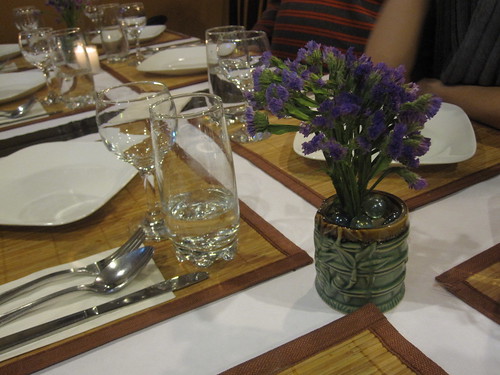
On a rainy Tuesday evening, ten of us gathered at Tito Rad's to explore Filipino food by the best method: tasting our way through as much of the menu as was humanly possible. At least, that's what I identified the common underlying goal to be, as the plates just kept on coming.
Stella had already ordered by the time I arrived, and was rushing out to fulfill the restaurant's BYOB option. During that time, Franny arrived bearing a bottle of Chardonnay for the group. We were just opening it up when Stella came back victorious with two six-packs of Heineken. After going through the meal and pairing the food with different beverages, some of the dishes can be constituted as "bar food", easily downed with a swig of beer. Since Filipino food is an eclectic mix of diverse ethnic influences, and our group was composed of various backgrounds, it seems appropriate that every element reflected the diversity of the cuisine.
So with our beverage supplies in no shortage, the flow of food began.

We began with a familiar looking dish, a pork spring roll with a sweet chili dipping sauce on the side. If you guessed that these bore a striking resemblance to Chinese spring rolls, you'd be right. Lumpiang Shanghai, as evidenced by the name, highlights the Chinese influence in Filipino food which still remains strong. Crispy, fried, and a slightly heavier version than the Chinese version that I'm accustomed to, I imagine these work great as finger food with a beer in hand.
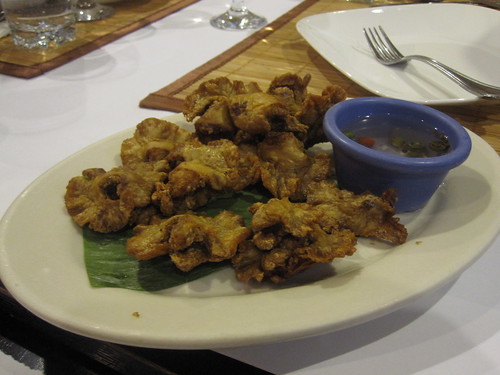
Another starter was the Chicharon Bulaklak. At first we called it fried pork rinds, but Stella explained it as the "pig muscle that holds together the intestines", although nobody really knows what that part is called. Chicharon in Filipino eating terms is "deep fried crunchified anything", though the word is an indicator of Spanish influence.

The second part of the name is poetic, as the word "bulaklak" is Tagalog for "flower". Each individual piece splayed out in a pretty little shape. Not to mention, this was another dish that pairs well with beer.
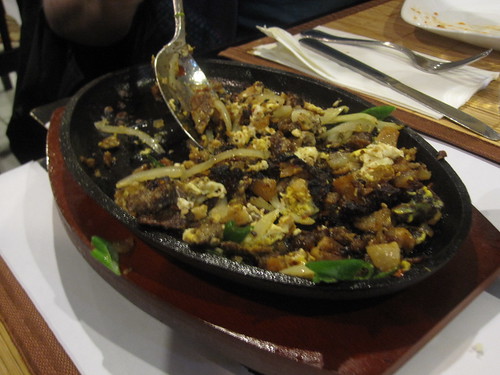
Consisting of boiled, grilled, and chopped up pork snout, ears, liver, and the additional eggs in this version, Sisig is the Filipino claim to snout-to-tail before it became all the rage here in the States. Sisig is the most popular, typical bar snack to pair with a beer. Clearly, the Heineken had earned their place at the dinner table.
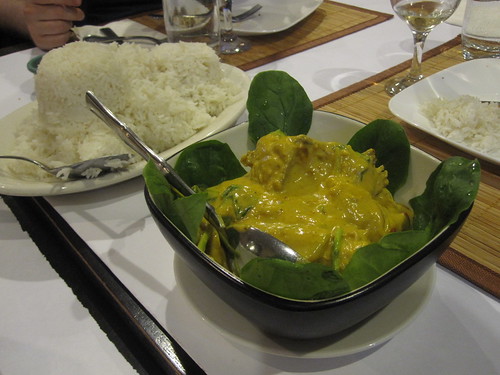
Next we moved onto pinpointing the Muslim influence with this hearty Chicken Curry, which isn't exactly that common in traditional Filipino cuisine. In fact, this was the only curry on the menu. The preparation wasn't mind-blowingly unique, but nevertheless delicious, especially when eaten with the funny boat-shaped mound of rice in the back.
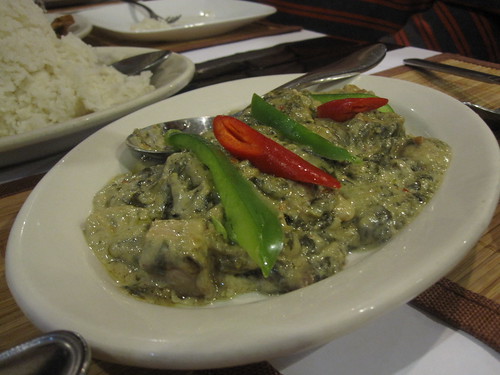
Now we're talking! Although it might not look like anything distinctive, Spicy Laing is made of taro leaves stewed in coconut milk. I couldn't really taste the spiciness in the dish, but I have no gripes about that. It had the creaminess and addictive power of a dip, with the added bonus of having taro leaves to help those of us who wanted to pretend it was healthier. Kind of like how artichoke and spinach dips are a good way to get in your daily dose of vitamins. Right, just like that. Moving on.
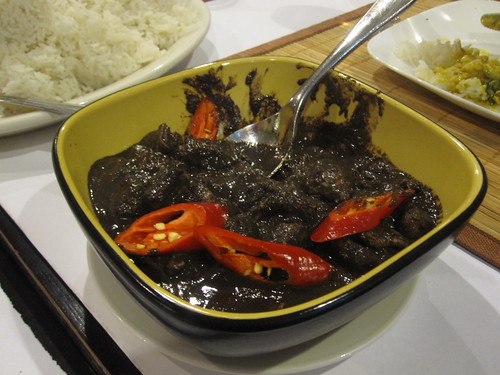
Some people might have heard of Dinuguan, or pigs blood stew, if only for the potential gross-out factor that's not really that disturbing once you taste it. I wasn't aware of what it was at the time, besides thinking "hm, this has a pretty strong flavor, but the meat is a little dry".

Regrettably, I didn't snap a better photo of the Abodong Baboy because it went pretty quickly. Understandably so, since this juicy pork/chicken was braised in a mixture of soy sauce, vinegar, and a little garlic that lent a strong flavor and impact to the final dish.
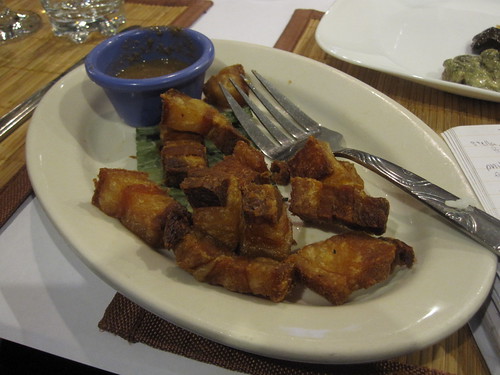
The Lechon Kawali appeared on the table sometime between the appetizers and the bigger entrees. It's basically fried pork belly with a sugary glaze. I'm already a big fan of pork belly, and I'm not going to argue with breaking out the deep fryer. It wasn't very greasy or heavy, and the fried aspect was more to add crisp and texture dimension than it was to distract the eater from being aware of what they're eating.
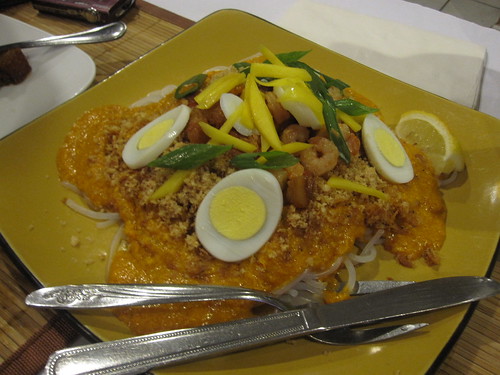
Then we moved on to noodles, or Pansit. This generously portioned one is called Palabok, with boiled eggs, shrimp, and good ol' chicharones on top of glass noodles. I heard some murmurs about it being too bland, but it was a nice accompaniment to the other bolder flavored dishes being passed around the table.
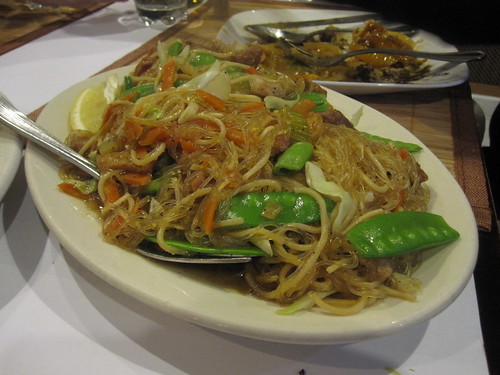
Bam-i is an interesting visayan pancit using a combination of both egg and glass noodles, whereas usually just one type is used. Mixed with snap peas and carrots, it reminded me of a similar preparation style in Chinese cuisine.

Another great Filipino dish to try if you've never had it before. Kare Kare is not for people who shy away from heavy sauces or comfort food. This bowl holds ox tail in a peanut-based soup with bits of bok choy, meant to be eaten with bagoong alamang (shrimp paste).
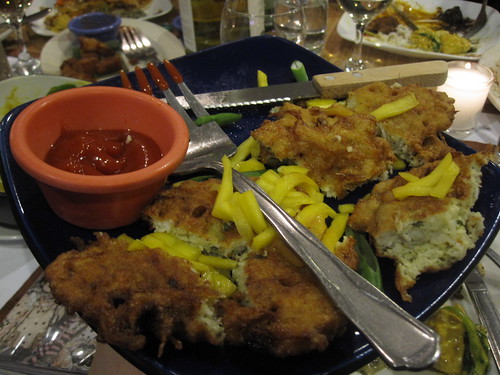
Tortang Dilis might not seem at first to be anything more than a speckled puff ball, but it's actually an omelette with dulong, tiny silver fish otherwise known as baby anchovies. The minuscule fish are used throughout Asian cooking, since my mom made a similar version with a flour batter, and similarly served with ketchup as a dipping sauce. Hey, influences stick!

Oh, Humba. You make me so happy when you arrive at the end of the meal, steaming hot and falling off the bones tender. Braised pork knuckle might induce more food euphoria than this gal can handle, so luckily there were nine other people to help take the burden off my stomach. It is slightly sweeter than the Chinese version, though the larger scale produced bigger, fattier, and softer pieces of meat.
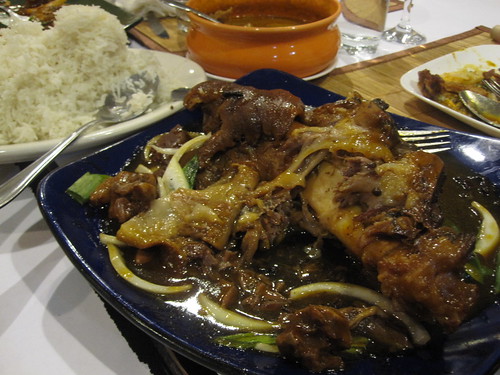
The aftermath. I kid you not when I say I could probably eat an entire portion myself, and I had to limit myself to only three helpings.
Time for my favorite part of the meal, DESSERT!
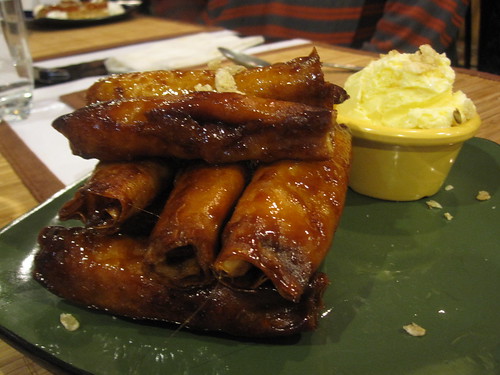
So technically, this isn't dessert. Stella explained that Turon is eaten as more of a midday, tea-time snack. It's sweet plantains with jackfruit inside eggroll wrappers, fried, and covered with sticky brown sugar. We couldn't really taste the jackfruit, but the scoop of vanilla ice cream on the side was a nice additional sugar boost. Because clearly, all of the above couldn't possibly be sweet enough.
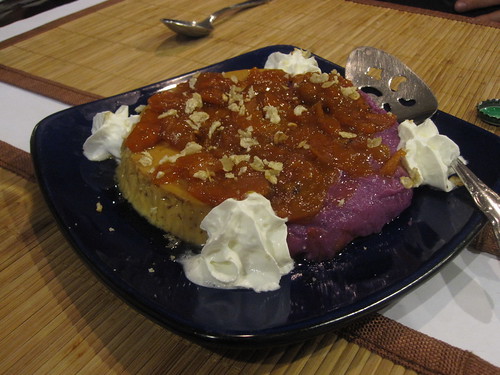
This was our primary dessert, or actually, it was more of a half and half split between two desserts since we were relatively full. Half was a dense, creamy Leche Flan, and the other was Ube Halaya. Ube, or purple yam, a popular ingredient in Filipino cooking, is not to be confused with Taro, a root vegetable used more in Chinese cuisines and has a much less vibrant purple color and a milder taste.
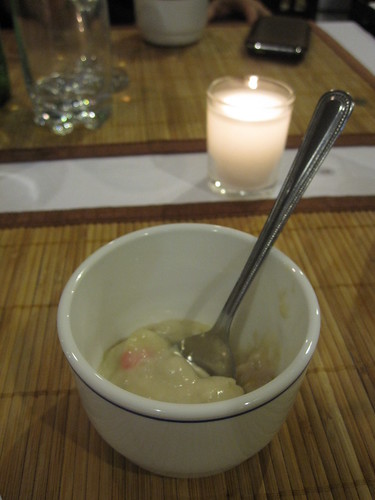
Finally, we all got a personal cup of Ginataan, the main component of which is coconut milk ("gata"). An array of add-ins, including sweet plantains, potatoes, taro, and sago are cooked in coconut milk to produce a thick, dense dessert that wasn't actually all that sweet. I think we were thankful for the tasting portion size after all of the other food we somehow polished off.
The night ended amicably with a mass photo session of all of us with the store owners. Stella lightheartedly exclaimed that Filipino people love to take photos, and well, who are we to argue with popular culture?
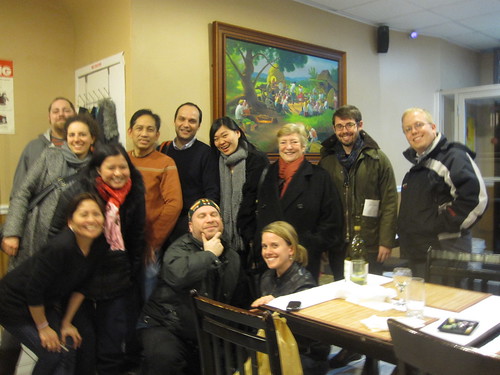
One big, happy, eating family! Even the store owners got some of their own cameras in there. We inadvertently stayed after closing hours, but they were quick and accommodating throughout the entire meal. The restaurant itself is in an intimate, unimposing space, with that certain warmth-of-home feel which makes ethnic hole-in-the-walls so satisfying. The final bill ended up being around $20 a head, and was reasonable considering how much food we ordered. I asked our food ambassador Stella why she chose Tito Rad's to host the dinner, and what she knew about the owners' backgrounds. This is what she had to say:
In the end, while most of the locals in our group walked off the meal, I split up and trekked back to Manhattan with a full belly and plenty of food for thought. Admittedly, most of that thought was what I would order the next time I return. Who's up for trying the rest of the menu?
Thanks to Stella for her constructive feedback in filling in gaps in my notes afterward, and to my fellow diners for being loads of fun to dine with. You can find more photos from the dinner with additional dishes and comments here.
Luckily, ethnic communities have spread to the various boroughs, leading to the development of dining blocks that have lured many a food seeker. One such find is Tito Rad's in Queens, where I, along with nine other food adventurers, had the fortune to attend dinner with our Filipino Food Ambassador, Stella, who guided us through the various aspects of Filipino cuisine.

On a rainy Tuesday evening, ten of us gathered at Tito Rad's to explore Filipino food by the best method: tasting our way through as much of the menu as was humanly possible. At least, that's what I identified the common underlying goal to be, as the plates just kept on coming.
Stella had already ordered by the time I arrived, and was rushing out to fulfill the restaurant's BYOB option. During that time, Franny arrived bearing a bottle of Chardonnay for the group. We were just opening it up when Stella came back victorious with two six-packs of Heineken. After going through the meal and pairing the food with different beverages, some of the dishes can be constituted as "bar food", easily downed with a swig of beer. Since Filipino food is an eclectic mix of diverse ethnic influences, and our group was composed of various backgrounds, it seems appropriate that every element reflected the diversity of the cuisine.
So with our beverage supplies in no shortage, the flow of food began.

We began with a familiar looking dish, a pork spring roll with a sweet chili dipping sauce on the side. If you guessed that these bore a striking resemblance to Chinese spring rolls, you'd be right. Lumpiang Shanghai, as evidenced by the name, highlights the Chinese influence in Filipino food which still remains strong. Crispy, fried, and a slightly heavier version than the Chinese version that I'm accustomed to, I imagine these work great as finger food with a beer in hand.

Another starter was the Chicharon Bulaklak. At first we called it fried pork rinds, but Stella explained it as the "pig muscle that holds together the intestines", although nobody really knows what that part is called. Chicharon in Filipino eating terms is "deep fried crunchified anything", though the word is an indicator of Spanish influence.

The second part of the name is poetic, as the word "bulaklak" is Tagalog for "flower". Each individual piece splayed out in a pretty little shape. Not to mention, this was another dish that pairs well with beer.

Consisting of boiled, grilled, and chopped up pork snout, ears, liver, and the additional eggs in this version, Sisig is the Filipino claim to snout-to-tail before it became all the rage here in the States. Sisig is the most popular, typical bar snack to pair with a beer. Clearly, the Heineken had earned their place at the dinner table.

Next we moved onto pinpointing the Muslim influence with this hearty Chicken Curry, which isn't exactly that common in traditional Filipino cuisine. In fact, this was the only curry on the menu. The preparation wasn't mind-blowingly unique, but nevertheless delicious, especially when eaten with the funny boat-shaped mound of rice in the back.

Now we're talking! Although it might not look like anything distinctive, Spicy Laing is made of taro leaves stewed in coconut milk. I couldn't really taste the spiciness in the dish, but I have no gripes about that. It had the creaminess and addictive power of a dip, with the added bonus of having taro leaves to help those of us who wanted to pretend it was healthier. Kind of like how artichoke and spinach dips are a good way to get in your daily dose of vitamins. Right, just like that. Moving on.

Some people might have heard of Dinuguan, or pigs blood stew, if only for the potential gross-out factor that's not really that disturbing once you taste it. I wasn't aware of what it was at the time, besides thinking "hm, this has a pretty strong flavor, but the meat is a little dry".

Regrettably, I didn't snap a better photo of the Abodong Baboy because it went pretty quickly. Understandably so, since this juicy pork/chicken was braised in a mixture of soy sauce, vinegar, and a little garlic that lent a strong flavor and impact to the final dish.

The Lechon Kawali appeared on the table sometime between the appetizers and the bigger entrees. It's basically fried pork belly with a sugary glaze. I'm already a big fan of pork belly, and I'm not going to argue with breaking out the deep fryer. It wasn't very greasy or heavy, and the fried aspect was more to add crisp and texture dimension than it was to distract the eater from being aware of what they're eating.

Then we moved on to noodles, or Pansit. This generously portioned one is called Palabok, with boiled eggs, shrimp, and good ol' chicharones on top of glass noodles. I heard some murmurs about it being too bland, but it was a nice accompaniment to the other bolder flavored dishes being passed around the table.

Bam-i is an interesting visayan pancit using a combination of both egg and glass noodles, whereas usually just one type is used. Mixed with snap peas and carrots, it reminded me of a similar preparation style in Chinese cuisine.

Another great Filipino dish to try if you've never had it before. Kare Kare is not for people who shy away from heavy sauces or comfort food. This bowl holds ox tail in a peanut-based soup with bits of bok choy, meant to be eaten with bagoong alamang (shrimp paste).

Tortang Dilis might not seem at first to be anything more than a speckled puff ball, but it's actually an omelette with dulong, tiny silver fish otherwise known as baby anchovies. The minuscule fish are used throughout Asian cooking, since my mom made a similar version with a flour batter, and similarly served with ketchup as a dipping sauce. Hey, influences stick!

Oh, Humba. You make me so happy when you arrive at the end of the meal, steaming hot and falling off the bones tender. Braised pork knuckle might induce more food euphoria than this gal can handle, so luckily there were nine other people to help take the burden off my stomach. It is slightly sweeter than the Chinese version, though the larger scale produced bigger, fattier, and softer pieces of meat.

The aftermath. I kid you not when I say I could probably eat an entire portion myself, and I had to limit myself to only three helpings.
Time for my favorite part of the meal, DESSERT!

So technically, this isn't dessert. Stella explained that Turon is eaten as more of a midday, tea-time snack. It's sweet plantains with jackfruit inside eggroll wrappers, fried, and covered with sticky brown sugar. We couldn't really taste the jackfruit, but the scoop of vanilla ice cream on the side was a nice additional sugar boost. Because clearly, all of the above couldn't possibly be sweet enough.

This was our primary dessert, or actually, it was more of a half and half split between two desserts since we were relatively full. Half was a dense, creamy Leche Flan, and the other was Ube Halaya. Ube, or purple yam, a popular ingredient in Filipino cooking, is not to be confused with Taro, a root vegetable used more in Chinese cuisines and has a much less vibrant purple color and a milder taste.

Finally, we all got a personal cup of Ginataan, the main component of which is coconut milk ("gata"). An array of add-ins, including sweet plantains, potatoes, taro, and sago are cooked in coconut milk to produce a thick, dense dessert that wasn't actually all that sweet. I think we were thankful for the tasting portion size after all of the other food we somehow polished off.
The night ended amicably with a mass photo session of all of us with the store owners. Stella lightheartedly exclaimed that Filipino people love to take photos, and well, who are we to argue with popular culture?

One big, happy, eating family! Even the store owners got some of their own cameras in there. We inadvertently stayed after closing hours, but they were quick and accommodating throughout the entire meal. The restaurant itself is in an intimate, unimposing space, with that certain warmth-of-home feel which makes ethnic hole-in-the-walls so satisfying. The final bill ended up being around $20 a head, and was reasonable considering how much food we ordered. I asked our food ambassador Stella why she chose Tito Rad's to host the dinner, and what she knew about the owners' backgrounds. This is what she had to say:
"I chose them because their food has always been consistent tasting and not greasy. Also, it feels more home made to me than the ones by 69th street and Woodside. I know they are from Cebu, the island discovered by Ferdinand Magellan. Their dialect is one that I can understand about half the time, but my siblings and I only grew up speaking Tagalog (and English for school) [..] another thing, the other restaurants have more tables and are more popular - it was just lucky that we came to Tito Rad's on a night that they weren't full and they gave us all their attention."
In the end, while most of the locals in our group walked off the meal, I split up and trekked back to Manhattan with a full belly and plenty of food for thought. Admittedly, most of that thought was what I would order the next time I return. Who's up for trying the rest of the menu?
Part of my life:
dining group,
ethnic,
Filipino,
foodies,
global ambassador,
queens
Subscribe to:
Posts (Atom)
